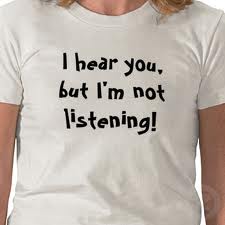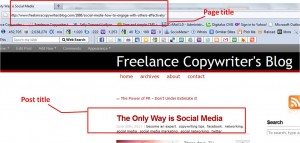Entries Tagged 'copywriting tips' ↓
June 29th, 2011 — copywriting tips, email copywriting, email marketing
 If your marketing strategy involves email marketing, you would most certainly have experienced some degree of churn.
If your marketing strategy involves email marketing, you would most certainly have experienced some degree of churn.
In a nut shell, churn relates to the number of subscribers lost over a period of time. These would be people who have unsubscribed from your list, emails that have bounced back or spam complaints.
It’s a fact of life and every business will have a churn rate, so you’re not alone.
Although you are unlikely to be able to prevent churn completely, there are steps you can take to reduce it.
1. Honesty is the best policy
Email marketing is all about building relationships. And the strongest relationships are built out of honesty and trust.
So, when you encourage someone to sign up make sure you tell them precisely what they’ll get (nature and frequency of the emails) and stick to it.
If your business offers more than one type of email (especially if you provide products/services to multiple market sectors) a great idea is to set up a preference centre so your subscribers can specify what information they want to receive from you.
Oh, and make sure you tell them about your privacy policy and how you will never pass on their email address to a third party.
2. Easy
Make the whole process easy for them. A simple opt-in and opt-out process is ideal. Although you don’t want to lose them from your list, it’s better to make it easy for them and retain them as a potential future customer than make them jump through hoops and annoy them.
3. Learn
You must remember that you and your employees are only human therefore mistakes will happen. When something goes wrong, or a subscriber simply gets bored of your communications send out a polite, brief email asking them for their opinion on your email marketing. If they respond it could shed some light on why they decided to unsubscribe (e.g. too many, too few, no longer relevant etc.) from your list.
4. Re-engage
This one is for all those inactive subscribers. They are the ones who perhaps immediately delete your email when it arrives or never click on any of the links etc.
Try to temp them back by creating a superb, not to be missed offer.
As you can see, if you engage in email marketing you will experience churn but there are a number of ways you can reduce its effect on your list.
What have your experiences been?
Do you have a high churn rate?
How do you re-engage people?
Please share your experiences by leaving a comment below.
June 27th, 2011 — copywriting tips, marketing, social media, social media marketing, social media training, social networking, twitter
Gemma Thompson is a communicator and endlessly curious. Use of Facebook & Twitter led to excellent brand awareness for her start-up business a few years ago. In less than a year she had a substantial ROI – £4,083 of business for £950 hours spend, and was being asked to teach others how she was doing it! She is now a full time social media consultant.
The author’s views are entirely her own and may not reflect the views of FreelanceCopywritersBlog.com. If you are interested in producing a Guest Post for this blog, please get in touch with your ideas.
 I hear so often that people are too busy to add social media into their business lives, and in fact I’ve felt the same way sometimes!
I hear so often that people are too busy to add social media into their business lives, and in fact I’ve felt the same way sometimes!
But social media is so much more than the sum of it’s parts, sure it’s great as a resource and fantastic as part of your marketing mix, but where social media really comes into it’s own is when it is recognised as being a channel for communication and used as such.
Danger Ahead!
The danger of being ‘too busy to tweet’ is that what that really means is that you are too busy to talk (and listen!) to your customers!
The times are not changing, they have changed. So many people use social media to interact with the business’s they buy from and they want to know that you value their custom. The easiest way to do this is to talk to them, listen to them, value their conversation and even enjoy it! Scandalous I know but then in my view business really should be fun!
But I do understand the demands on time, particularly if you are a small business or sole trader, of course you can’t put off doing the work your customers are paying you to do!
Phew – A Safe Passage!
However once your selected social media channels are set up and you know what your strategy is, social media doesn’t have to steal away every minute of your day. In fact I regularly recommend to my clients that they check in just three times a day, first thing in the morning, just before or after lunch and just before the end of the day. This pattern was strongly recommended to me when email became something that threatened to overwhelm the world and I find it holds true for social media too.
There are also many tools on the Market now that can help you fit it into your day efficiently, spending time with a social media strategist can help you define which of these will be right for you.
If you really can’t squeeze 30 minutes a day of social media use into your day then I’m afraid it is time to ask yourself what you are doing that could be changed, is it time to take on an accountant instead of slogging through your receipts yourself? Maybe hiring a virtual assistant to help with your filing or outsourcing your copywriting will help? It may be that you need to employ an additional staff member.
Whatever you need to do, do it. It’s vital you take the time to talk with your customers through social media, and it is most time efficient and effective when it is you that does it. Yes I offer social media management as part of my services, but it’s not what I recommend in the majority of cases. Nobody knows your business like you do, and nobody can change things as quickly as you when your customer base is telling you they need something else. So make that time, 30 minutes a day to communicate with your customers, because they’re worth it!
June 22nd, 2011 — copywriting tips, online marketing, Page titles, search engine optimisation, seo, Title tags
When it comes to SEO, your page title is everything.
It is probably the most important search engine optimisation factor as it exists to help the search engine understand what your page is all about. And if it understands that, you’ll appear in the right search engine results pages.
But many people confuse their page title and their post title.
Your post title is exactly that, the name you have given to your blog post. Your page title is usually auto generated and therefore tends to be the same as your post title.

But the key to optimising your SEO is to make these different. Many platforms, such as Word Press, allow you to easily alter your page title to something that will carry more SEO weight.
What does that mean?
Well, to make sure your post comes up in relevant search engine results make sure you include your keywords in the first half of your page title. You will only have 65 characters to play with so make sure you make every one count by creating a page title that is meaningful.
This is something that should be done for any website, not just a blog.
But select your keywords carefully – don’t cram them all into your page title because that won’t make sense. Use the word(s) that’s most relevant to that page and then create something that answers the searchers question.
So, for example, if they were searching for a site to help with dog behavioural problems, a site with a title such as “Dog Behavioural Problems – Advice and training videos” will show that that website probably has the answer they are looking for.
Another common mistake is to repeat the page title in the META Description. Remember your page title is for SEO; your META Description is there to attract the click-through. It should convince the searcher that your site is the one that will help them so make sure it is meaningful.
Getting your page titles (or title tags) right is vital for a successful SEO campaign. After all, if you don’t clearly tell the search engines what your website is about, how can it list you in the appropriate search results?
Open a new page in your browser and open your website or blog. What is your page title? Is it really working as hard as it can?
This simple change really can make a huge different in your website’s effectiveness.
Author: Sally Ormond, professional freelance copywriter with Briar Copywriting.
June 20th, 2011 — become an expert, copywriting tips, facebook, networking, social media, social media marketing, social networking, twitter
 These days, TV schedules seem to be full of reality TV shows. We appear to be obsessed with human behaviour (admittedly at times, it’s not so human) – how different people react in situations and how they interact with each other.
These days, TV schedules seem to be full of reality TV shows. We appear to be obsessed with human behaviour (admittedly at times, it’s not so human) – how different people react in situations and how they interact with each other.
Whether you love them or loathe them, they do offer an insight into the world of social media and the people you will meet there.
Although social media happens in a virtual world, you will still come across the usual people profiles:
- Shy
- Confrontational
- Opinionated
- Funny (and those who think they’re funny)
- Confident
- Flirty…
The list is endless. This is why social media interaction should be based on real life interaction. You may not be speaking with people face to face but they are real people.
Make friends
If you were at a party you would mingle and chat, that’s what you need to do on social media. If you are a natural wall flower this is the perfect opportunity to make an impression.
In a real life situation you may not have the confidence to approach people and chat with them (especially if you don’t know them). But in social media you can because you don’t have to physically approach them. Sat in front of your computer, you can be whoever you want to be.
Join the conversation but make sure you leave your sales hat off. Concentrate on adding value to others rather than asking favours. Offer advice and information and become a valued member of the community.
Social butterfly
You must know someone who always manages to effortlessly fit into any social group, always has crowds of people around them hanging on their every word and generally being irritatingly popular.
Emulate that person by sharing tips, stories and advice. Also encourage others to join in the conversation by inviting readers to leave comments on your blog posts – get a debate started.
Always ask questions and be interested in others and what they have to say. If you engage with others in this way they’ll want to talk to you.
Watch out for the bully
Sadly they exist everywhere, even on social media.
There’ll always be someone somewhere ready to start a fight – they’ll disagree with everything you say and try to run you down.
First of all, if you can avoid this type of situation, do so. But if it does happen, don’t run and hide. Make sure you express your opinion and stand up to them but…
- Think before you speak – you don’t want to antagonise the situation
- Read your comment before posting – how does it sound? You don’t want to lose credibility through a knee-jerk reaction
- If you can add facts and figures to your reply – use stats to back up your position
- Don’t reply in haste – remember your comment will be on the internet forever
So, as you can see, social media really is a lot like real life. All sorts of people use it – some to engage with others and make new friends and contacts, others to promote their services and products.
To get the most from it you have to be part of it. Whether it’s Facebook, Twitter or blogging, dive in and join the conversation.
Do you have any tips you can share on engaging in social media?
Perhaps you’ve found yourself in a situation that’s been quite difficult or you’ve been the victim of a social media bully? If so, how did you deal with it?
Please share your experiences by leaving a comment below.
Author – Sally Ormond, freelance copywriter at Briar Copywriting and social media addict
June 17th, 2011 — copywriter, copywriting, Copywriting careers, copywriting tips, UK copywriter
 If you’re thinking about becoming a copywriter, there’s one thing you must get – a very thick skin.
If you’re thinking about becoming a copywriter, there’s one thing you must get – a very thick skin.
Over the years mine has thickened to rival any Rhino – that doesn’t conjure a particularly attractive image, but it is a necessity when you write for a living.
I’ve been in business as a freelance copywriter since 2007. I’m pretty good at what I do, in fact I would go so far as to say I’m an expert in my field – that’s why companies from all over the world come to me when they need help with their marketing copy.
The process is fairly simple:
- The client makes contact
- I ask for a full brief on which to base a quote
- They say ‘yes please’
- I write the copy
- They review it
- Everyone’s happy
OK, in an ideal world it would work that way. But frequently there’s a few extra steps added between 5 and 6.
You will soon discover that, no matter how experienced you are, clients will criticise your copy. I will admit that when I first started out this was, at times, hard to take. After all, I’d spent hours pouring over concepts to come up with the finished article.
Some won’t like the approach you’ve taken, others will tell you how they would write it – even though you’re the professional they’ve hired to do the work.
But the one thing you have to remember is that the criticism isn’t directed at you personally.
Copywriting is a very collaborative process. Sometimes you’ll hit it right first time and there’ll be no amendments to be done. Other times there may be a few tweaks needed and the key is to talk to your client, discuss their ideas and together produce a revised version.
Just like art, writing is very subjective – what you know is right may not be so obvious to your client.
So what do you do when they change your copy?
First, take a deep breath. Then review what they’ve said, make any change requests that are valid and then take the time to explain why you wrote the copy in the way you did. Show them the elements within the copy and how they work together. Be confident and stand up for what you believe to be right (without causing an unpleasant scene) and if you know what they are asking you to do is wrong, tell them – nicely.
They’ll have far more respect for you if you take the time to explain a concept than if you say “OK, if that’s how you want it written” knowing full well it won’t achieve the results they’re looking for.
At the end of the day, believe in yourself and your abilities but leave your ego at the door. Plus it also helps to keep sound bites to hand from clients who were happy with your work so in moments of self doubt you can remind yourself how good you are.
 If your marketing strategy involves email marketing, you would most certainly have experienced some degree of churn.
If your marketing strategy involves email marketing, you would most certainly have experienced some degree of churn. I hear so often that people are too busy to add social media into their business lives, and in fact I’ve felt the same way sometimes!
I hear so often that people are too busy to add social media into their business lives, and in fact I’ve felt the same way sometimes!
 These days, TV schedules seem to be full of reality TV shows. We appear to be obsessed with human behaviour (admittedly at times, it’s not so human) – how different people react in situations and how they interact with each other.
These days, TV schedules seem to be full of reality TV shows. We appear to be obsessed with human behaviour (admittedly at times, it’s not so human) – how different people react in situations and how they interact with each other. If you’re thinking about becoming a
If you’re thinking about becoming a 




